The medium that we are most familiar with is words. We write proposals, produce reports and even our presentations are full of bullets and written texts. We also like numbers. They are the hard evidence about measurable trends, indicators of a present state or change over a time interval. Despite the value of trend indicators, there are no facts and data about the future. In our exploration of the future, we need to tap into our imagination and see a future that is not there yet. And clearly we don’t see just with words and numbers. Pictures and images help us see. Good practice of the toolbox of visualization is a great advantage in foresight projects and trend research. But both facilitators and participants in our sessions are often not very familiar with visualization. We say we cannot draw or design and prefer the comfort zone of writing. Here are four ways in which visualization can enhance the collaborative thinking process in foresight projects.
Visualization to speed up the thinking process
Many foresight projects are dealing with highly complex problems and abstract concepts. Difficult issues that cannot be reframed into simple questions or be understood through one thinking paradigm. Scientific discussion for instance on water-food-energy nexus problems can keep the thinking processes limited to scientific understanding and scientific solutions. Visualization allows other elements to be introduced in the discussion, especially if words have not crystalized the thinking yet.
A picture says more than a thousand words. Ideas that have emerged in a group conversation can be quite fragile, not yet fully defined. But a first picture of what people see in their head can help to carry the conversation further. It allows to build upon each others imagination and find new patterns as a basis for storylines. Outside of the box thinking is kick-started by visuals. Pictures allow new stories to be created and recreated.
Open up sensory modalities beyond our analytical reasoning
In particular when addressing complex, interconnected challenges, ‘normal’ text-based reasoning is not enough. When visualizing the thinking processes, our creative senses are activated and different parts of the brain are engaged. This associative, experiental and embodied thinking helps to grasp elements of the storylines of the future, that are outside of the scope of our analytical reasoning brain. Visualizing the your storyline will get people to create a better understanding of what it is means to live in this future, hence see the consequences of today’s decision making.
Visualization to make the future tangible
Even a paper mock-up of a future product enables a group to communicate about things that are not there. The moment you can see and touch it, people start believing in a product and start talking about for instance how they would use it, like or dislike it and so on. The same applies to cityscapes of the future or new societal concepts. Seeing what it looks like is the beginning of a conversation on the impact of these new things, how it applies to what we know about the way things works. A mock-up or display immediately gets people to reinterpret what they know, to see the impact of new things in an old context or old things in a new context. These can be seen as artifacts to rehearse for the future.
Build an integral framework, combining pictures, numbers and words
Combining information from different modalities creates a richer framework of the future. This enables a group conversation which involves different people, some triggered by images, some by quantitative indicators, and some by a logically composed storyline. This interaction of people with different thinking styles and different backgrounds and education can open up new insights in solutions that emerge from these frameworks of the future. As such, the unique advantage of creating integral frameworks is that it facilitates settings where a mixed group of people feel confident that they can contribute to the conversation.
Foresight practitioners who know how to use visualization as part of their toolbox will experience that these techniques can speed up the thinking process and help to see the impact of new technologies or societal developments. Mastery of the toolbox of visualization helps to understand how to tap into people’s creative modus and unlock this potential in them.
There is a broad range of visualization techniques to work with. From co-creative drawing to professionally rendered computer images. From enhanced street views on paper board to virtual reality goggles. From paper mock-ups to fake products, hardly distinguished from real products. Each technique has its own advantage for a particular context. Which one would work the best can only be evaluated by considering the dynamics of the project.

